by Maxine Carter-Lome
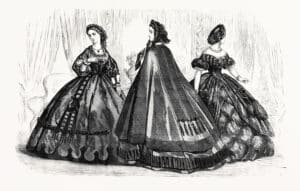
as illustrated in this “Mourning Costume” print.
Mourning attire has evolved throughout the centuries but one thing that has remained constant, at least in western civilizations, is the wearing of the color black. Originally reserved for royalty and aristocracy who were experiencing grief, black mourning dress eventually became a fashion statement worn by people of all classes who wished to emulate the ways and dress of the elite. Over the last 150 years, mourning rituals and attire have taken on many influential shades of centuries-old observances but have evolved to meet the needs of modern-day mourners, whose loss is no less profound than the generations before them but whose conventions today are more practical and less severe.
The Evolution of Mourning in Black
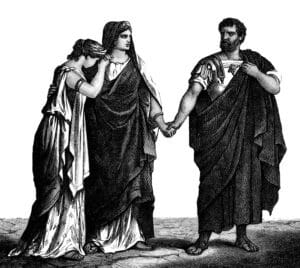
The custom of wearing unadorned black clothing for mourning dates back at least to the Roman Empire, when the toga “pulla,” made of dark-colored wool, was worn during mourning; however, black wasn’t always the color of mourning in the west. For centuries, white was worn in mourning by most. This is because white was the most affordable fabric color and one most people already had. Even after black became the color of mourning in the west, children still wore white to funerals as a sign of innocence and purity.
During the Middle Ages and Renaissance, black mourning attire was worn by aristocrats and royals for both personal loss as well as general loss, such as after the St. Bartholomew’s Day Massacre. Women and widows wore distinctive black caps and veils, and all mourning dress was heavily regulated and monitored to fit a strict dress code.
For the next 500 years, mourning conventions and fashions in Western Europe were dictated by royal protocol, and the wearing of black as a symbol of mourning remained the purview of royalty and the aristocracy. That changed during the 18th century with a shift in wealth across Western Europe that rewarded entrepreneurship over inheritance. As wealthy European merchant families and a growing middle class rose in the ranks during the Georgian era (1714-c. 1830-37), they looked to mimic the royal family in their mourning, and display their newfound wealth, by wearing black and adopting the fashion of mourning dress.
On March 1, 1738, the Virginia Gazette printed the news of the death of “Her Majesty Wilhelmina Dorothea Carolina, Queen Consort of Great Britain.” Instructions were given as to mourning attire, as well as decoration, for “Peers, Peerettes, Privy-Counsellors, and Foreign Ministers” mourning the Queen. This included the particulars of what constituted “Full Dress” for men and women. For women, “full dress” was: “Black Bombazeen, broad hemm’d Cambrick Linen, Crape Hoods, Shammy Shoes and Gloves, and Crape Fans.” The article specified their “undress” as: “Dark Norwich Crape, and glaz’d Gloves.” Gentlemen, on the other hand, were instructed to wear “Black Cloth, without Buttons on the Sleeves or Pockets, Cambrick Cravats, and Weepers, broad hemm’d, Shammy Shoes and Gloves, Crape Hatbands, Black Swords, Buckles, and Buttons.” The instructions go on, to say that “Coaches and Chairs” should be covered in black cloth, servants should wear “Shoulder-Knots of Black Silk Ribbon …” and that deep mourning should last six months, followed by another six months of second mourning.
When Martha Washington’s daughter, Martha (“Patsy”) Parke Custis, died in 1773, both George and Martha Washington observed 15 months of deep, half, and second mourning as was prescribed for the death of a child. Washington ordered from London a “genteel Suit of Second Mourning, such as is worn by Gentlemen of taste, not those who are running into the extreme of every fashion,” as well as a “genteel mourning sword, with belt, swivel, etc.” Martha required a “Black Silk Sacque & Coat” with “1 handsome Fan proper for Second Mourning.” Martha also placed an order with their mourning attire for “mourning rings,” most probably containing Patsy’s hair, to give to her girlfriends and relatives as a remembrance.
The growing demand across Europe and from the Colonies for appropriate mourning attire was met through the extensive manufacture of dull black mourning wools, black and white silk mourning crapes, and jewelry. Court and private dressmakers and tailors would then make up mourning garments to suit the specific styles required by these widening consumer groups and new royal decrees. The world’s chief manufacturer of mourning crape was a British company called Courtaulds, which mechanized the production process for massive output and established a veritable monopoly on its creation. The company exported the material internationally, with particular success in the United States and France.
Mourning in the Victorian Era
The wearing of black as mourning dress reached its peak during the reign of Queen Victoria (1819-1901) during the second half of the 19th century. Queen Victoria, whose love for her husband Prince Albert was legendary, took mourning to a whole new level with his death in 1861. In addition to wearing her widow’s weeds for the remaining forty years of her life, she requested that the Prince’s rooms in their residences remain and be maintained exactly as he had them when he was alive (her servants were instructed to bring hot water into his dressing room every day as they had formerly done for his morning shave), had statues made of him, and displayed his personal mementos around the royal palaces.
As in other aspects of her reign, Queen Victoria’s mourning for her husband influenced mourning etiquette among almost all classes, high and low, and decreed a new complex set of rules governing bereavement rituals, including appropriate periods of mourning by family members and the wearing of black.
Unsurprisingly, women bore the brunt of the emotional labor that this culture of mourning demanded, and no woman was more constrained by cultural expectations than a widow. Widows were expected to observe a prescribed period of mourning and dress appropriately in black during that time. That period was extended during the Victorian Era to no less than two years for a spouse. To change one’s clothing earlier than that was considered disrespectful to the deceased, and, if the widow was still young and attractive, suggestive of potential sexual promiscuity.
The Stages of Mourning Wear
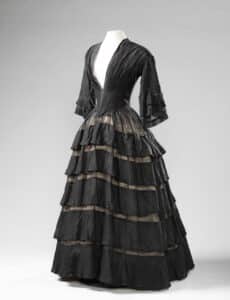
wool mousseline photo: Amsterdam Museum
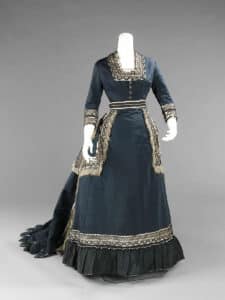
c. 1872-74. Brooklyn Museum Costume Collection at The Metropolitan Museum of Art. photo: met.org
To outwardly display their bereavement, widows were to spend roughly two and a half years in total proceeding through three stages of mourning—deep mourning, full or second mourning, and half or “light” mourning—each with its own fashion requirements and restrictions on behavior.
Deep mourning took place immediately after the death and, according to social protocol, lasted a year and a day. This period required a widow to wear simple black dresses and don a full-length black veil anytime she left the house. Called a “weeping veil,” this shroud was made of a crimped silk fabric called crape (spelled with an “a” when referring to mourning clothing), allowing one to “weep with propriety,” as the women’s magazine M’me Demorest’s Quarterly Mirror of Fashions put it in 1862. Unfortunately, due to the dyes and chemicals used to process the fabric, these veils could also cause skin irritation, respiratory illness, blindness, and even death.
In addition to heavy veils of black crape, custom also required women to wear heavy, concealing black clothing. The entire ensemble was colloquially known as “widow’s weeds” (from the Old English word, meaning “garment”). Mourning jewelry, often made of jet, was also worn and became highly popular in the Victorian era. Jewelry was also occasionally made from the hair of the deceased. The wealthy also wore cameos or lockets designed to hold a lock of the deceased’s hair or some similar relic.
Given the cost of mourning dress, an extravagance for all but the wealthy, most women overdyed clothing they already owned. The protocol did not require that their dress be constructed entirely or exclusively of crape, rather, “covered” with crape as part of its construction, which made altering and dying an existing costume for mourning more affordable and accessible. To complete a mourning ensemble, they could purchase special caps, bonnets, veils, and fans, usually in black or other dark colors.
As one’s time advanced to the next stage of mourning, dress became less restrictive. During second mourning, which lasted six to nine months, women could abandon the veil and crape and introduce ornate jewelry but were expected to continue to wear crape tucks, which consisted of crape material gathered into bunches at intervals, on their dresses. Half mourning was the final state and lasted three to six months during which time the widow wore muted colors such as violet, navy, and dark green.
Men, on the other hand, were not expected to adhere to rigid mourning rules. Following the burial, they were expected to return to work in order to support the family. Men could wear a long crape band on their hat called a “weeper.” The width of the weeper around his hat represented his relationship with the deceased. Other optional men’s fashions included black armbands or a black ribbon on the lapel.

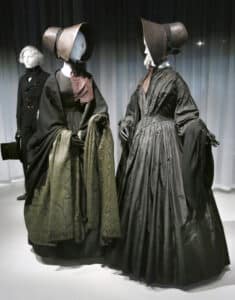
Ready-to-Wear Mourning
By 1900, the growing demand among all social classes for mourning wear, and the lack of black dye needed to custom create every single piece for any woman needing it, created an opportunity for industrial clothing manufacturers, who began mass-producing affordable “ready-to-wear” mourning attire, including mourning dresses, jewelry, hats, veils, handkerchiefs, and gloves.
These ready-to-wear pieces were then advertised to women, many of whom did not live in a city center, through catalogs such as Montgomery Ward, Bloomingdale Brothers, and Sears. Soon, department stores and mourning specialty stores began marketing the sale of socially prescribed mourning attire.
“Advances in textile manufacturing combined with a new consumer appetite for mourning apparel also led to the establishment of stores—like Besson & Son in Philadelphia and Jackson’s Mourning Warehouse in Manhattan—that sold ready-made mourning clothes and fabric, as well as ribbons, hats, rings, gloves, handbags, shoes, flowers, and even black drapery for the house, while department stores like Lord & Taylor added mourning departments,” writes Author Jocelyn Sears.
The department store Jordan Marsh in Boston advertised that mourning clothes were always stocked for immediate delivery. Their mourning dress “number 7” was described as being a “very pretty wool French cashmere costume, waste trimmed with handsome lace effect bolero, crushed collar, and belt, finished with mourning silk ribbon, skirt cut in Parisian style.” They guaranteed “Dresses can be made to order from any measurement in two days.”
To help educate and assimilate a new class of mourners, fashion magazines published illustrations of the latest mourning fashion, and etiquette books were published instructing people how to dress to properly grieve for different family members.
Over the next century, mourning became more practical and abbreviated. Widow’s weeds were replaced by black armbands, simple dark-colored clothing, and the pinning of mourner ribbons. The only constant? The heartbreak of loss and the color black.
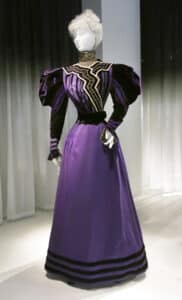
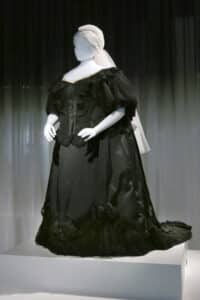
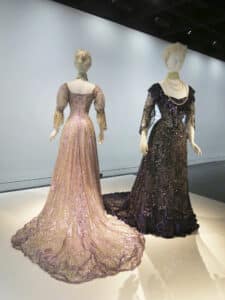





Related posts: